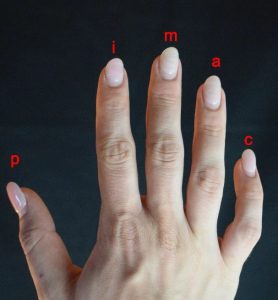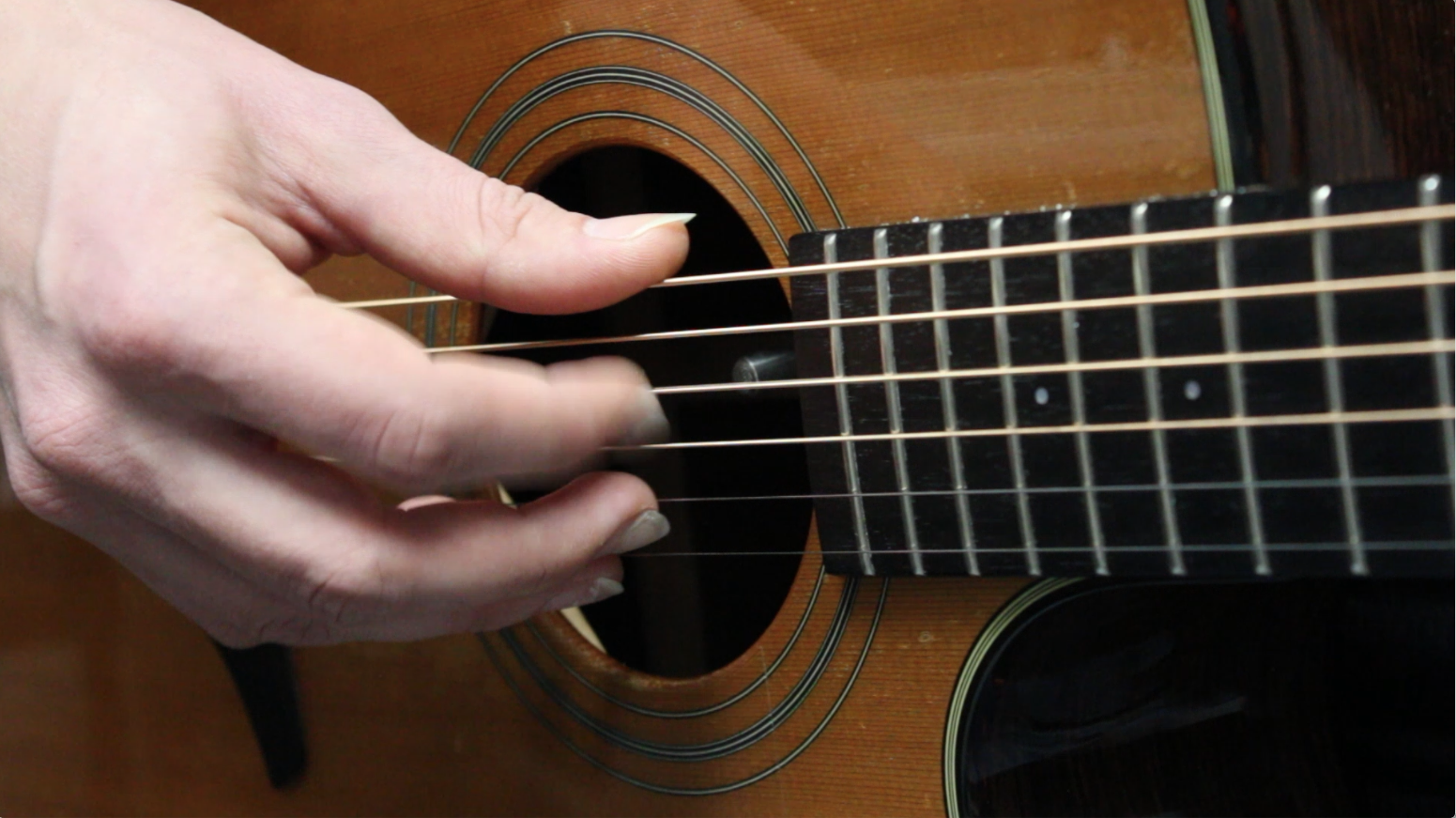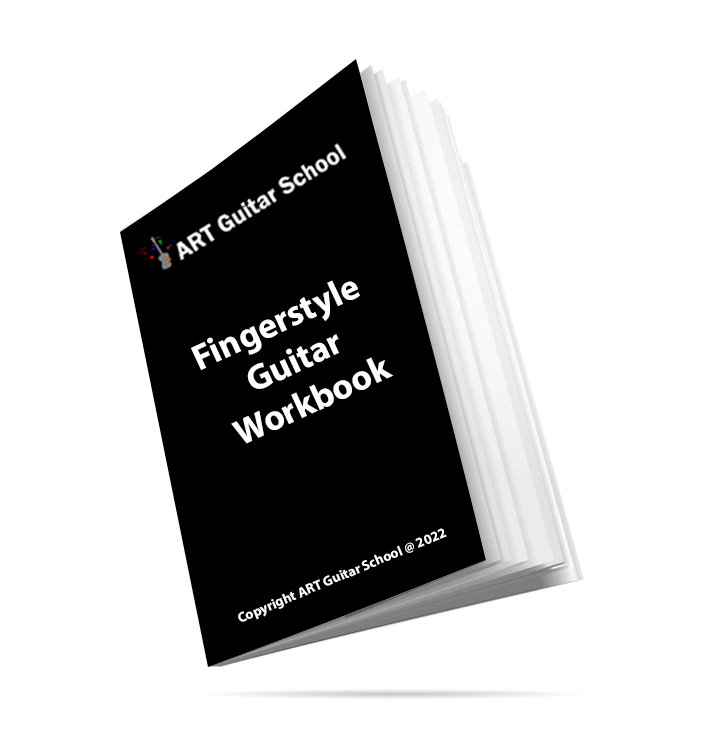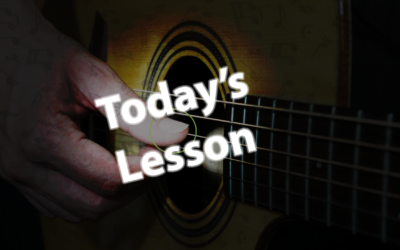FINGERPICKING KEY

The right hand:
P = Thumb
I = Index
M = Middle
A = Ring
Fingerpicking Pattern No. 1
This is the most essential fingerpicking pattern to start with. It requires no left hand chord or fretted notes. It is used in many popular fingerpicking songs and some songs are slight variations of this same pattern.
We have all open strings being plucked in sequential order. Each note is a quarter note in duration and will last exactly one second each if played at 60bpm.
Lets get to playing!
We will pluck each open string in order starting from the 6th string (Low E) and ending on the 1st (High E).
Step 1. Lets start with thumb (p) and pluck the 6th-4th string
Step 2. Pluck index (i), middle (m) and ring (a) on the 3rd-1st strings.

Here is a video demonstration of the finger picking pattern:
If you were having trouble please contact us and we will help you!
FOLLOW US ON
Get our FREE Fingerstyle Workbook!
RELATED BLOG POSTS
Understanding Guitar Notation
Guitar notation is a system of symbols and markings that are used to communicate musical ideas and instructions to guitar players. Unlike traditional sheet music notation for other instruments, guitar notation is specific to the guitar and includes unique symbols and techniques that are essential for playing the instrument effectively.
One of the key elements of guitar notation is the use of tablature, or tabs. Tabs are a visual representation of the guitar fretboard, with numbers indicating which fret to play on each string. Tabs make it easier for guitarists to learn and play new songs quickly, as they provide a clear and concise way to visualize where to place their fingers on the fretboard.
Another important aspect of guitar notation is the use of chord diagrams. Chord diagrams show the placement of fingers on the fretboard to form different chords. This visual representation helps guitarists quickly learn and memorize new chords, allowing them to play a wider variety of songs and styles.
In addition to tablature and chord diagrams, guitar notation also includes standard notation symbols such as notes, rhythms, dynamics, and articulations. These symbols provide valuable information about how to play a piece of music, including the tempo, volume, and expression required to accurately perform a musical passage.
Understanding guitar notation is essential for any guitarist looking to improve their playing and musical knowledge. By familiarizing yourself with tabs, chord diagrams, and standard notation symbols, you can effectively communicate and interpret musical ideas, play a wider variety of music, and develop your skills as a guitarist.
Overall, guitar notation is a powerful tool that allows guitarists to communicate and interpret musical ideas effectively. By learning how to read and interpret tabs, chord diagrams, and standard notation symbols, you can improve your playing, expand your musical repertoire, and become a more versatile and knowledgeable guitarist.
Reading Guitar Tabs
Have you ever looked at a sheet of guitar tabs and felt completely lost? Guitar tabs are a popular way for guitar players to learn new songs without having to read traditional sheet music. They use a simple system of lines and numbers to show you where to place your fingers on the guitar neck.
While reading guitar tabs may seem daunting at first, with a little practice, you’ll be able to pick up new songs in no time. The key to reading guitar tabs is understanding the basic structure. The lines represent the strings of the guitar, with the bottom line representing the low E string and the top line representing the high E string.
The numbers on the lines indicate which fret to press down on that string. For example, if you see a “3” on the bottom line, you would press down on the third fret of the low E string. If you see a “0,” that means to play the string open, without pressing down on any frets.
One important thing to remember when reading guitar tabs is that they only show you where to place your fingers on the fretboard. They do not indicate the rhythm or timing of the song. You’ll need to listen to the original recording or use a metronome to get the timing right.
Practice is key when it comes to reading guitar tabs. Start with simple songs and work your way up to more complex tunes. Take your time and don’t get frustrated if you don’t get it right away. With a little patience and persistence, you’ll be reading guitar tabs like a pro in no time.
So next time you come across a sheet of guitar tabs, don’t be intimidated. Take a deep breath, pick up your guitar, and dive in. You’ll be playing your favorite songs in no time.
How to Develop a Unique Fingerstyle Guitar Style
Every guitar player has their own voice, their unique sound that sets them apart from others. Fingerstyle guitar is no exception—it’s a deeply personal form of expression that can evolve as you continue to experiment with techniques, rhythms, and melodies. If you want to develop a distinct fingerstyle guitar style, it’s essential to approach your playing with creativity, originality, and a willingness to explore new ideas. In this post, we’ll discuss how to nurture and develop a unique fingerstyle guitar style.
1. Understand Your Influences
Before you can create your own unique sound, it’s essential to understand the great fingerstyle guitarists who have come before you. Listening to iconic fingerstyle players will help you identify what resonates with you musically. These players have already developed distinctive sounds through their technique, tone, and approach to music.
Study the Masters: Some of the greats in fingerstyle guitar include Chet Atkins, Tommy Emmanuel, John Butler, Andy McKee, and Michael Hedges. Each of these players has a unique style, whether it’s in their choice of tuning, fingerpicking technique, or their rhythmic approach.
Incorporate What You Like: Pay attention to what you love about their playing—whether it’s the groove, the complexity, or the sound of their fingerpicking. While you shouldn’t copy these artists outright, incorporating elements of their playing can inspire your own development.
2. Experiment with Different Tunings
Alternate tunings are a powerful way to develop a unique fingerstyle style. When you change the standard tuning of your guitar, you unlock new chord voicings, melodies, and sounds that wouldn’t be available in regular tuning.
Try Open Tunings: Open tunings, like Open D or Open G, allow you to play full chords without barring the strings, making it easier to focus on melody and rhythm with your fingers.
Create Your Own Tunings: Some of the most innovative fingerstyle guitarists have developed their own tunings. Don’t be afraid to experiment with unconventional tunings to discover fresh harmonic possibilities.
3. Develop Finger Independence
Finger independence is crucial for creating complex and fluid fingerstyle patterns. The ability to control the thumb, which handles bass notes, while simultaneously moving the other fingers to pluck the higher strings opens up a world of possibilities for creating intricate, multi-layered textures in your music.
Practice Bass and Melody Separately: To develop finger independence, practice separating the bass notes (usually played with the thumb) from the melody (played with the other fingers). Focus on each hand independently to build up your control and coordination.
4. Incorporate Percussive Elements
One way to make your fingerstyle playing stand out is by incorporating percussive elements into your technique. Many fingerstyle guitarists use their palm or fingers to tap on the body of the guitar, creating rhythmic sounds that complement the music.
Tap on the Body: Try incorporating subtle taps, slaps, or muted hits to create a rhythmic pulse along with your fingerpicking. These percussive effects add a new dimension to your playing.
Explore Finger Slaps and Pops: By using the fleshy part of your thumb or fingers to slap or pop the strings, you can add a dynamic, percussive layer to your playing, similar to slap bass in funk music.
5. Be Creative with Chord Voicings and Fingerpicking Patterns
One of the most important aspects of developing a unique style is experimenting with different chord voicings and fingerpicking patterns. Don’t just stick to the basic open chords—explore barre chords, suspended chords, and other voicings that create richer textures.
Create New Patterns: Experiment with different right-hand fingerpicking patterns that break away from traditional up-down picking. Combining irregular patterns, syncopated rhythms, or finger rolls will give your playing a distinctive feel.
Use Non-Standard Chords: Don’t be afraid to use more complex or unconventional chord shapes. Use diminished, augmented, or suspended chords to add more color and movement to your music.
6. Add Your Own Musical Touch
The most unique fingerstyle players are those who inject their own personality and emotions into their music. Whether it’s through rhythm, tone, or phrasing, your individuality will shine through when you make the music your own.
Play What You Feel: Don’t be afraid to express your emotions through your playing. Focus on how the music makes you feel rather than strictly following the notes on the page. This emotional connection is often what makes a style truly unique.
Experiment with Dynamics: Use dynamics—playing softly, loudly, or somewhere in between—to create tension and release. Playing with contrast will make your style more expressive and dynamic.
Conclusion
Developing a unique fingerstyle guitar style takes time and experimentation, but it’s incredibly rewarding. By exploring different tunings, mastering finger independence, incorporating percussive elements, and adding your own musical touches, you can create a distinctive sound that is all your own. Don’t be afraid to experiment, and most importantly, have fun while doing it!




0 Comments